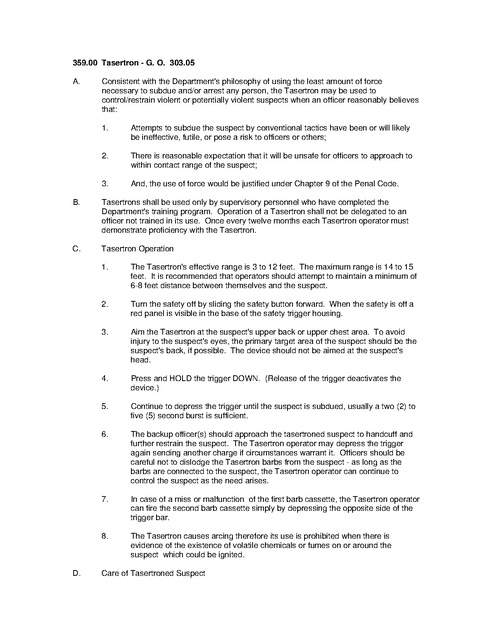Taser Irving Tasertron
Download original document:

Document text

Document text
This text is machine-read, and may contain errors. Check the original document to verify accuracy.
359.00 Tasertron - G. O. 303.05 A. Consistent with the Department's philosophy of using the least amount of force necessary to subdue and/or arrest any person, the Tasertron may be used to control/restrain violent or potentially violent suspects when an officer reasonably believes that: 1. Attempts to subdue the suspect by conventional tactics have been or will likely be ineffective, futile, or pose a risk to officers or others; 2. There is reasonable expectation that it will be unsafe for officers to approach to within contact range of the suspect; 3. And, the use of force would be justified under Chapter 9 of the Penal Code. B. Tasertrons shall be used only by supervisory personnel who have completed the Department's training program. Operation of a Tasertron shall not be delegated to an officer not trained in its use. Once every twelve months each Tasertron operator must demonstrate proficiency with the Tasertron. C. Tasertron Operation D. 1. The Tasertron's effective range is 3 to 12 feet. The maximum range is 14 to 15 feet. It is recommended that operators should attempt to maintain a minimum of 6-8 feet distance between themselves and the suspect. 2. Turn the safety off by sliding the safety button forward. When the safety is off a red panel is visible in the base of the safety trigger housing. 3. Aim the Tasertron at the suspect's upper back or upper chest area. To avoid injury to the suspect's eyes, the primary target area of the suspect should be the suspect's back, if possible. The device should not be aimed at the suspect's head. 4. Press and HOLD the trigger DOWN. (Release of the trigger deactivates the device.) 5. Continue to depress the trigger until the suspect is subdued, usually a two (2) to five (5) second burst is sufficient. 6. The backup officer(s) should approach the tasertroned suspect to handcuff and further restrain the suspect. The Tasertron operator may depress the trigger again sending another charge if circumstances warrant it. Officers should be careful not to dislodge the Tasertron barbs from the suspect - as long as the barbs are connected to the suspect, the Tasertron operator can continue to control the suspect as the need arises. 7. In case of a miss or malfunction of the first barb cassette, the Tasertron operator can fire the second barb cassette simply by depressing the opposite side of the trigger bar. 8. The Tasertron causes arcing therefore its use is prohibited when there is evidence of the existence of volatile chemicals or fumes on or around the suspect which could be ignited. Care of Tasertroned Suspect E. F. 1. A person that has been restrained by use of the Tasertron shall be examined by Paramedics at the scene to determine if the suspect should be transported to P.M.H. 2. Tasertron barbs which become imbedded in the skin of the suspect will be removed by IFD Paramedics at their discretion or the suspect may be transported to P.M.H. 3. Once the suspect has been restrained and shows no sign of violent resistance, the Tasertron barbs should be removed from his clothing. Care and Maintenance of Tasertron/Batteries 1. The Tasertron should be kept in its case (in the Sergeant's vehicle) until needed. 2. The device may be wiped off with a damp cloth if it becomes dirty. The battery and barb cartridges should be removed first and the Tasertron allowed to dry before reinsertion of the battery 3. There are two batteries assigned for each Tasertron - one for the Tasertron and the other for recharging rotation. Batteries will be marked with the Tasertron's serial number and an A or B designation. 4. Day shift Taser operators shall replace batteries every morning. Batteries should be rotated every 24 hours to ensure maximum charge. 5. Batteries should be replaced once a year with new batteries. 6. No other maintenance is needed. Any device which appears damaged or defective shall be forwarded with an explanation of the problem to the Property Room Supervisor. Tasertron Operator Responsibilities: 1. 2. G. The Tasertron operator that uses the Tasertron shall complete: a. Memo to the Chief of Police. *b. Less lethal Control Device Critique Form. Both reports will be submitted to the Watch Commander as soon as possible. Watch Commander Responsibilities: 1. Ensure that the use of the Tasertron conforms to this SOP and G.O. 303.05. 2. Ensure the completeness and accuracy of the Tasertron operator's reports. 3. Ensure that the reports are available to the Division Commander by the end of the watch.

